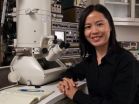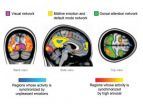(Press-News.org)
VIDEO:
Berkeley Lab researchers at the National Center for Electron Microscopy recorded real-time observations of nanocrystal growth that support the theory of nanoparticles acting like artificial atoms. This electron microscopy movie...
Click here for more information.
In the growth of crystals, do nanoparticles act as "artificial atoms" forming molecular-type building blocks that can assemble into complex structures? This is the contention of a major but controversial theory to explain nanocrystal growth. A study by researchers at the U.S. Department of Energy (DOE)'s Lawrence Berkeley National Laboratory (Berkeley Lab) may resolve the controversy and point the way to energy devices of the future.
Led by Haimei Zheng, a staff scientist in Berkeley Lab's Materials Sciences Division, the researchers used a combination of transmission electron microscopy and advanced liquid cell handling techniques to carry out real-time observations of the growth of nanorods from nanoparticles of platinum and iron. Their observations support the theory of nanoparticles acting like artificial atoms during crystal growth.
"We observed that as nanoparticles become attached they initially form winding polycrystalline chains," Zheng says. "These chains eventually align and attach end-to-end to form nanowires that straighten and stretch into single crystal nanorods with length-to-thickness ratios up to 40:1. This nanocrystal growth process, whereby nanoparticle chains as well as nanoparticles serve as the fundamental building blocks for nanorods, is both smart and efficient."
Zheng is the corresponding author of a paper describing this research in the journal Science. The paper is titled "Real-Time Imaging of Pt3Fe Nanorod Growth in Solution." Co-authors are Hong-Gang Liao, Likun Cui and Stephen Whitelam.
If the near limitless potential of nanotechnology is to even be approached, scientists will need a much better understanding of how nano-sized particles can assemble into hierarchical structures of ever-increasing organization and complexity. Such understanding comes from tracking nanoparticle growth trajectories and determining the forces that guide these trajectories.
Through the use of transmission electron microscopy and liquid observation cells, scientists at Berkeley Lab and elsewhere have made significant progress in observing nanoparticle growth trajectories, including the oriented attachment of nanoparticles - the chemical phenomenon that starts the growth of nanocrystals in solution. However, these observations have typically been limited to the first few minutes of crystal growth. In their study, Zheng and her colleagues were able to extend the time of observation from minutes to hours.
"The key to studying the growth of colloidal nanocrystals with different shapes and architectures is to maintain the liquid in the viewing window long enough to allow complete reactions," Zheng says. "We dissolved molecular precursors of platinum and iron in an organic solvent and used capillary pressure to draw the growth solution into a silicon-nitride liquid cell that we sealed with epoxy. The sealing of the cell was especially important as it helped keep the liquid from turning viscous over time. Previously, we'd often see the liquids become viscous and this would prevent the nanoparticle interactions that drive crystal growth from taking place."
Zheng and her colleagues chose to study the growth of platinum iron nanorods because of the electrocatalytic material's promising potential for use in next generation energy conversion and storage devices. They were able to observe these nanoparticles assemble into nanorod crystals using powerful transmission electron microscopes at Berkeley Lab's National Center for Electron Microscopy, including TEAM 0.5 (Transmission Electron Aberration-corrected Microscope), which can produce images with half angstrom resolution – less than the diameter of a single hydrogen atom.
"From what we observed only single nanoparticles exist at the beginning of crystal growth, but, as growth proceeds, small chains of nanoparticles become dominant until, ultimately, only long chains of nanoparticles can be seen," Zheng says. "Our observations provide a link between the world of single molecules and hierarchical nanostructures, paving the way for the rational design of nanomaterials with controlled properties."
INFORMATION:
This research was supported by the DOE Office of Science.
Lawrence Berkeley National Laboratory addresses the world's most urgent scientific challenges by advancing sustainable energy, protecting human health, creating new materials, and revealing the origin and fate of the universe. Founded in 1931, Berkeley Lab's scientific expertise has been recognized with 13 Nobel prizes. The University of California manages Berkeley Lab for the U.S. Department of Energy's Office of Science. For more, visit www.lbl.gov.
The U.S. Department of Energy's Office of Science, the single largest supporter of basic research in the physical sciences in the United States, is working to address some of the most pressing challenges of our time. For more information, please visit science.energy.gov.
Nanoparticles seen as artificial atoms
Berkeley Lab researchers observations of nanorod crystal growth points way to next-generation energy devices
2012-05-28
ELSE PRESS RELEASES FROM THIS DATE:
Knowing genetic makeup may not significantly improve disease risk prediction
2012-05-28
Boston, MA —Harvard School of Public Health (HSPH) researchers have found that detailed knowledge about your genetic makeup—the interplay between genetic variants and other genetic variants, or between genetic variants and environmental risk factors—may only change your estimated disease prediction risk for three common diseases by a few percentage points, which is typically not enough to make a difference in prevention or treatment plans. It is the first study to revisit claims in previous research that including such information in risk models would eventually help doctors ...
Pivotal role for proteins -- from helping turn carbs into energy to causing devastating disease
2012-05-28
(SALT LAKE CITY)—Research into how carbohydrates are converted into energy has led to a surprising discovery with implications for the treatment of a perplexing and potentially fatal neuromuscular disorder and possibly even cancer and heart disease.
Until this study, the cause of this neuromuscular disorder was unknown. But after obtaining DNA from three families with members who have the disorder, a team led by University of Utah scientists Jared Rutter, Ph.D., associate professor of biochemistry and Carl Thummel, Ph.D., professor of human genetics, sequenced two genes ...
Discarded data may hold the key to a sharper view of molecules
2012-05-28
CORVALLIS, Ore. — There's nothing like a new pair of eyeglasses to bring fine details into sharp relief. For scientists who study the large molecules of life from proteins to DNA, the equivalent of new lenses have come in the form of an advanced method for analyzing data from X-ray crystallography experiments.
The findings, just published in the journal Science, could lead to new understanding of the molecules that drive processes in biology, medical diagnostics, nanotechnology and other fields.
Like dentists who use X-rays to find tooth decay, scientists use X-rays ...
No new neurons in the human olfactory bulb
2012-05-28
Research from Karolinska Institutet in Sweden shows that the human olfactory bulb – a structure in the brain that processes sensory input from the nose – differs from that of other mammals in that no new neurons are formed in this area after birth. The discovery, which is published in the scientific journal Neuron, is based on the age-determination of the cells using the carbon-14 method, and might explain why the human sense of smell is normally much worse than that of other animals.
"I've never been so astonished by a scientific discovery," says lead investigator Jonas ...
Gene discovery points towards new type of male contraceptive
2012-05-28
A new type of male contraceptive could be created thanks to the discovery of a key gene essential for sperm development.
The finding could lead to alternatives to conventional male contraceptives that rely on disrupting the production of hormones, such as testosterone and can cause side-effects such as irritability, mood swings and acne.
Research, led by the University of Edinburgh, has shown how a gene – Katnal1 – is critical to enable sperm to mature in the testes.
If scientists can regulate the Katnal1 gene in the testes, they could prevent sperm from maturing ...
Drug allergy discovery
2012-05-28
A research team led by the University of Melbourne and Monash University, Australia, has discovered why people can develop life-threatening allergies after receiving treatment for conditions such as epilepsy and AIDS.
The finding could lead to the development of a diagnostic test to determine drug hypersensitivity.
The study published today in the journal Nature, revealed how some drugs inadvertently target the immune system to alter how the body's immune system perceives it's own tissues, making them look foreign.
The immune system then attacks the foreign nature ...
Beetle-infested pine trees contribute to air pollution and haze in forests
2012-05-28
The hordes of bark beetles that have bored their way through more than six billion trees in the western United States and British Columbia since the 1990s do more than kill stately pine, spruce and other trees.
Results of a new study show that these pests can make trees release up to 20 times more of the organic substances that foster haze and air pollution in forested areas.
A paper reporting the findings appears today in the journal Environmental Science & Technology, published by the American Chemical Society.
Scientists Kara Huff Hartz of Southern Illinois University ...
Feeling strong emotions makes peoples' brains 'tick together'
2012-05-28
Experiencing strong emotions synchronises brain activity across individuals, research team at Aalto University and Turku PET Centre in Finland has revealed.
Human emotions are highly contagious. Seeing others' emotional expressions such as smiles triggers often the corresponding emotional response in the observer. Such synchronisation of emotional states across individuals may support social interaction: When all group members share a common emotional state, their brains and bodies process the environment in a similar fashion.
Researchers at Aalto University and ...
Dramatic increase in fragility fractures expected in Latin America
2012-05-28
The International Osteoporosis Foundation (IOF), in cooperation with medical and patient societies from throughout Latin America, has today published a landmark report which compiles osteoporosis-related data on 14 countries and the region as a whole. The report shows that fragility fractures due to osteoporosis are predicted to more than double in some countries in the coming decades.
Osteoporosis, which literally means 'porous bones', is a disease which causes bones to become fragile and more likely to break. Older adults, and post-menopausal women in particular, are ...
In Brazil number of hip fractures expected to increase 32 percent by 2050
2012-05-28
A new Audit report on fragility fractures, issued today by the International Osteoporosis Foundation (IOF), predicts that Brazil will experience an explosion in the number of fragility fractures due to osteoporosis in the coming decades.
Osteoporosis, a disease which weakens bones and makes them more likely to fracture, is thought to affect around 33% of postmenopausal women in Brazil. Fractures due to osteoporosis mostly affect older adults, with fractures at the spine and hip causing the most suffering, disability and healthcare expenditure.
Currently, about 20% ...
LAST 30 PRESS RELEASES:
Study finds brain care score can predict risk of stroke across racial groups
Key lung immune cells can intensify allergic reactions
Do hormones explain why women experience more gut pain?
New materials conduct ions in solids as easily as in liquids
Breakthrough of the Year: Renewable energy begins to eclipse fossil fuel-based sources
LLM use is reshaping scientific enterprise by increasing output, reducing quality and more
Introducing LightGen, a chip for ultra-fast, ultra-efficient generative AI
Astronomers see fireworks from violent collisions around nearby star
ACC/AHA issue new guideline on managing congenital heart disease in adults
Cosmic crash caught on camera
Is talented youth nurtured the wrong way? New study shows: top performers develop differently than assumed
Ants: An untapped resource in the development of antibiotics?
Archaeologists use AI to create prehistoric video game
Mitochondria migrate toward the cell membrane in response to high glucose levels
Tiny viral switch offers hope against drug-resistant bacteria
Most parents aware of early peanut introduction guidelines, but confused about details
HPV vaccine can protect against severe lesions of the vulva and vagina
Virtual care provision and emergency department use among children and youth
Quadrivalent HPV vaccine and high-grade vulvovaginal lesions
Insights into dry eyes gained from stem cell-derived tear glands
Researchers identify 166 human pluripotent stem cell lines available for use in clinical applications
Europa Clipper instrument uniquely observed interstellar comet 3I/ATLAS
UN University Report challenges climate change as sole trigger of Syrian Civil War, exposing governance failures in drought response
Real estate investment trust (REIT) acquisition associated with hospital closure and bankruptcy
New Raman imaging system detects subtle tumor signals
Boston Children’s receives a $7.5 million grant from Aligning Research to Impact Autism (ARIA) to provide clinical research coordination for the IMPACT Network
Spray-on antibacterial coating offers new protection for plants against disease and drought
ESMT Berlin study: What makes a first offer successful in negotiations
Groundbreaking ceremony marks the beginning of CTAO-South Array construction in Chile
Why swearing makes you stronger
[Press-News.org] Nanoparticles seen as artificial atomsBerkeley Lab researchers observations of nanorod crystal growth points way to next-generation energy devices


